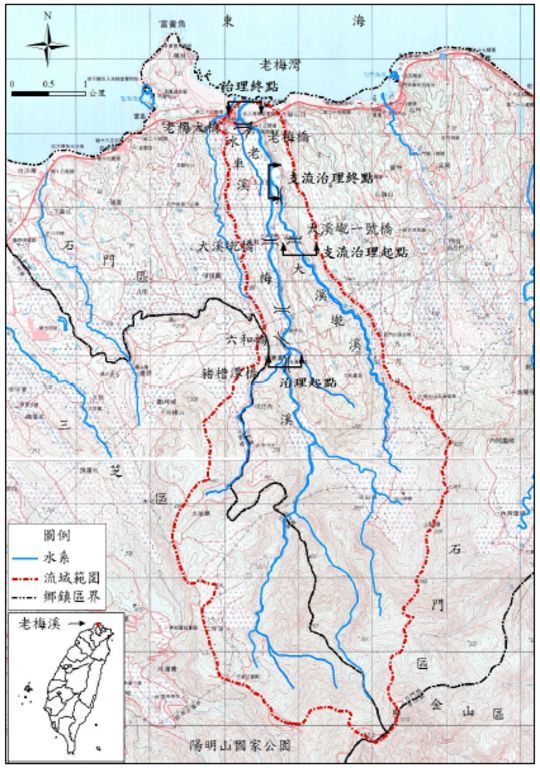This is Laomei Beach. In addition to the famous green stone trough, Laomei Beach has a little-known special feature, that is, the beach here contains a lot of magnetite sand. In the past, the areas of Jinshan and Fuguijiao were important mining sites for iron-making raw material-magnetite. Laomei Beach can be said to be the source of these mining areas, but how did the magnetic sand in Laomei Beach come from? This EarthCache will take you to Laomei Beach to pan the sand and trace the source of the sand based on the geological knowledge.
這裡是老梅沙灘,除了著名的綠石槽之外,老梅沙灘有一個鮮為人知的特別之處,那就是這邊的沙灘中含有大量的磁鐵砂。在過去,金山與富貴角一帶曾為煉鐵原料-磁鐵礦的重要開採地點。而老梅沙灘可說是這些開採地的源頭,但是老梅沙灘的鐵礦砂又是怎麼來的呢?這個地質寶將帶你去老梅沙灘淘沙,並且依據地質知識來追尋這些砂的源頭。
Where does these magnetic sand come from? / 磁鐵砂從哪裡來?
Magnetite is mainly secondary minerals of basalt and andesite. The picture below shows the distribution of northern igneous rocks.
磁鐵礦主要為玄武岩與安山岩的副成分礦物,下圖為北部火成岩分布圖。

In this picture, the marked location is Laomei Beach. We can see that the pink color is tuff , and the maroon horizontal line is pyroxene andesite.These rocks are derived from the volcanic activity of Mount Zhuzi. The lava flow distribution area of Mount Zhuzi is extremely large, and it is the largest volcano in the Tatun volcano group. From the igneous rock distribution map above, it can be seen that some of the Mount Zhuzi lava flow flows into the sea through Fuguijiao.Therefore, we can infer that part of the magnetite sand comes from the andesite at the seaside, and is transformed into sand on the beach after the weathering and erosion of the waves and sea breeze.
上圖打星的位置就是老梅沙灘,我們可以看到在附近粉色底的是凝灰岩,而褐紅色橫線的是輝石安山岩,這些岩石都是源自於竹子山的火山活動。竹子山熔岩流分布區域極為廣大,是大屯火山群中覆蓋面積最大的火山。由上圖的火成岩分佈圖可以看到有部分的竹子山熔岩流經由富貴角流入海中,因此我們可以推測,部分的磁鐵砂是來自於海邊的安山岩,經過海浪與海風的風化侵蝕作用,而化成海邊的砂。

In addition to weathering and erosion, there is another driving force that creates this magnetized sand beach, which is Fluvial processes.
而除了風化侵蝕外,還有另一個造就出這片充滿磁鐵沙海灘的推手,就是河流作用。
The above picture shows the drainage area of the Laomei River. The estuary of Laomei River is beside Laomei Beach. Taking Fuguijiao as the base point, comparing the Laomei River watershed and the northern igneous rock distribution map in this picture, it is not difficult to find that the Laomei River watershed almost overlaps with the distribution of pyroxene andesite, not to mention that the source of Laomei River comes from Mount Zhuzi.
For the reasons above, we can infer that the magnetite sand of Laomei Beach also comes from the erosion of the Mount Zhuzi igneous rock by the Laomei River, and the river will transport these magnetite sand to the estuary and accumulate on the beach.
上圖為老梅溪的流域圖,老梅溪的出海口就在老梅沙灘旁。以富貴角為基點,對比這張圖中老梅溪的流域與北部火成岩的分布圖,不難發現老梅溪的流域幾乎與輝石安山岩的分布重疊,更遑論老梅溪的源頭就來自於竹子山。因此,我們可以判斷老梅沙灘的磁鐵砂也來自老梅溪對竹子山火成岩的侵蝕,並經由河流作用將這些磁鐵砂搬送到出海口並堆積到沙灘上。
Therefore, under the interaction of volcanoes, oceans, and rivers, a special magnet sand beach like Laomei Beach was born. Next, let’s prepare the needed tools and try to search for the magnetic sands, and experience this special natural resource that was born in a unique environment.
因此在火山、海洋、河流彼此的交互作用之下,才誕生了老梅沙灘這樣特殊的磁鐵沙海灘,接下來請準備好工具讓我們如淘金般的淘磁鐵,一起體驗一下這誕生於得天獨厚環境下的特殊自然資源吧。
Note: You'll need some tools for this EarthCache! Two pieces of paper, a strong magnet (Neodymium magnet is recommended), a container to seperate the sand, and a iron material (e.g. nail). This EarthCache is only answerable if you bring all the needed tools and follow the following steps to complete the experiment.
注意:請準備以下工具-兩張紙、強力磁鐵、容器(用來分離沙),以及任意鐵製品(例如鐵釘)。你必須攜帶所有所需工具並且按照以下步驟完成實驗才能夠完整的回答問題並且線上登錄這個地質寶。

Steps of the experiment / 實驗步驟
- Took some sand (about a coin) from the beach and put it on a pieces of paper.
在海灘上拿取一些沙(大約一個硬幣的量),並將其放在一張紙上。
- Cover it with another piece of paper, and then use a magnet slowly moving around on the paper to collect the magnetic sand.
覆蓋另一張紙在上面,隔著紙慢慢地用磁鐵畫圈將磁鐵砂收集起來。
- Put the attracted sand into the container. (Since it's across the paper, so it should be easy to seperate the sand, if you have any difficulty for this step, you probably did something wrong, please try again from begin.)
將吸起來的沙放入容器中。(因為是隔著紙吸的,所以應該很容易就能夠將沙分離,如果你在這個步驟中遇到了任何困難,你可能是有哪邊做錯了,請從頭再試一次。)
※Please note that the experiment may not work perfectly if the sand is wet.
※請注意,如果沙灘上的沙是潮濕的狀態,則實驗可能無法順利進行。
To log this cache, please answer the following questions:
- Continue the experiment above:
a. Observe the sand that you collect, how many magnetic sand is contained inside? (%)
觀察你所收集到的沙子,請問磁鐵砂的含量大約占多少比例?(%)
b. Put the iron material inside the magnetic sand that you collect, is the magnetic sand attached on the iron material? Is all the magnetic sand attached on it? Why it is/isn't? In your opinion, why is this experiment step important? Please explain your answer.
將鐵製品放入你所收集的磁鐵砂中,請問磁鐵砂會吸附在鐵製品上嗎?是所有的磁鐵砂都會吸附在上面嗎?為什麼是/不是?你認為為什麼這個實驗步驟是重要的?請解釋你的答案。
- Observe the surrounding of the Laomei beach:
a. Try to looking for the trace of where the magnetic sand come from, and explain the source you found is based on what kind of the effect that made the magnetic sand.
請試著在老梅沙灘附近尋找磁鐵沙來源的蹤跡,並說明你找到的來源是基於什麼作用下產生磁鐵沙的。
b. In your opinion, why the magnetic sand on the beach that wouldn't get rust?
你覺得為什麼沙灘上的磁鐵砂不會生鏽呢?
- The below picture is the map of northern coastline of Taiwan:

Based on what you've learned on this EarthCache, are the other beaches that marked on the map also contain the magnetic sand? If the answer is yes, please list the beaches in an order of the percentage that the magnetic sand contained from the most to the less, and explain your answer. If the answer is no, please also explain your answer.
根據你在這個地質寶所學到的東西,你覺得地圖上所列出的其他沙灘也含有磁鐵砂嗎?如果你的答案是肯定的,請將這些沙灘可能含有的磁鐵砂含量由大到小排序,並解釋你的答案。如果你的答案是否定的,也請說明原因。
- Take a photo with the magnetic sand that you collected, the photos must contain either you (no face required), your personal item, a piece of paper with your geocaching name, or any else that would makes your photos unique.
拍張你用磁鐵所收集到的磁鐵沙上傳吧!(拿磁鐵直接往沙灘上吸會超級有趣的喔!XD)
Notes:
- You MUST bring the needed tools to do the experiment and answer the questions.
- Please don’t post any answers in your log.
- Please send the answers to the owner via message system of geocaching.com. Only the accounts that sent the answers could log as found, so please make sure you sent your own answers even you’re in the group-hunting.
- You MUST visit the earthcache location to claim a find. I’ll delete the logs of people who clearly didn’t visit the earthcache or who didn't complete the logging tasks.
- You don’t have to wait the permission to log after you send the answers. Any logs without all of the answers will be deleted.
REF: 臺灣火成岩的分布, 陽明山國家公園, 臺灣河川復育網, Wikipedia, 臺灣地質知識服務網